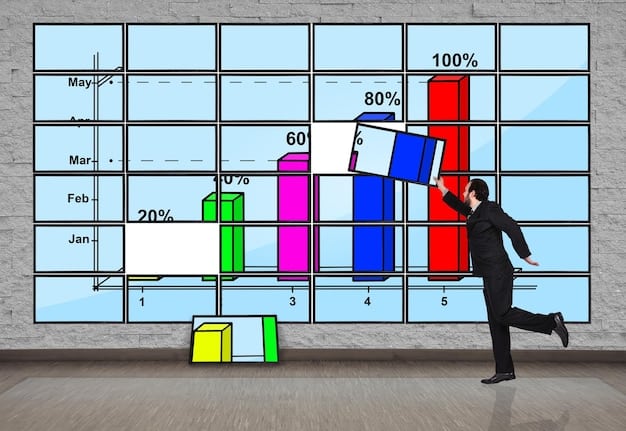Unlock Productivity: The Pareto Principle for Ultimate Efficiency

The Pareto Principle, also known as the 80/20 rule, suggests that 80% of your results come from 20% of your efforts; by focusing on these vital tasks, you can significantly boost productivity and achieve more with less effort.
Are you feeling overwhelmed by your to-do list? The Pareto Principle, or the 80/20 rule, offers a powerful framework for prioritizing tasks and maximizing your productivity by focusing on the 20% of efforts that yield 80% of the results.
Understanding the Pareto Principle
The Pareto Principle, often referred to as the 80/20 rule, is a universally applicable principle stating that roughly 80% of effects come from 20% of causes. This principle can be applied to various fields, from economics to personal productivity.
Initially observed by Italian economist Vilfredo Pareto, the principle noted that 80% of the land in Italy was owned by 20% of the population. This distribution, however, is not a rigid law, but rather a guideline for understanding imbalances in cause and effect.
Historical Context
Vilfredo Pareto, observing wealth distribution in Italy, identified that a small percentage of people controlled a disproportionately large share of the nation’s wealth. This observation later extended beyond economics.
Core Concept
The essence of the Pareto Principle lies in recognizing that not all inputs are created equal. Some inputs are significantly more impactful than others. Identifying and focusing on these crucial inputs can lead to substantial gains.
- Identify key tasks.
- Prioritize tasks that yield the most significant impact.
- Focus intensely on these high-impact activities.
By understanding the Pareto Principle, one can strategically direct efforts towards activities that produce the highest yield, optimizing resources and enhancing productivity. It encourages a shift in focus from being busy to being effective.
In conclusion, the Pareto Principle is a powerful tool for prioritizing and focusing on the most impactful tasks, providing a strategy for increased efficiency in both personal and professional contexts.

Applying the Pareto Principle to Productivity
Applying the Pareto Principle to productivity involves identifying the 20% of tasks that produce 80% of your desired outcomes. This strategic prioritization helps maximize your efficiency and focus.
To effectively use the 80/20 rule, start by assessing your current tasks and responsibilities. Determine which activities are truly contributing the most to your goals, and which are merely time-consuming without producing significant results.
Task Assessment
Begin by making a list of everything you do in a typical week. Include both personal and professional tasks to get a comprehensive view of your activities.
Prioritization Techniques
Once you have a list, evaluate each task’s impact on your overall goals. Use a scale or rating system to quantify the value of each task, helping you identify the top 20%.
- Rank tasks by impact.
- Cut out low-value activities.
- Delegate where possible.
By applying the Pareto Principle, you can reallocate your time and energy to tasks that truly move the needle, reducing wasted effort and increasing overall productivity. This targeted approach ensures every minute is spent effectively.
In essence, applying the Pareto Principle helps you streamline your workflow, focus on high-impact activities, and achieve more with less effort, making it an invaluable tool for anyone seeking to optimize their productivity.
Benefits of Focusing on High-Impact Tasks
Focusing on high-impact tasks, the 20% that drives 80% of the results, provides numerous benefits including increased productivity, reduced stress, and improved satisfaction.
Prioritizing tasks based on their impact allows you to concentrate your energy where it matters most, resulting in a more efficient use of time and resources. This focus leads to achieving goals more quickly and effectively.
Increased Efficiency
When you focus on high-impact tasks, you avoid spreading yourself too thin. This targeted approach allows for deeper concentration and better execution.
Reduced Stress
Knowing that you’re working on the tasks that truly matter can alleviate stress. It provides a sense of control and purpose, reducing feelings of being overwhelmed by inconsequential tasks.
Delegating or eliminating low-impact tasks frees up time to focus on strategic activities.
When you focus on high-impact tasks, you see tangible results more frequently, boosting motivation and job satisfaction. This positive feedback loop further enhances productivity and overall well-being.
Ultimately, concentrating on the 20% of tasks that yield 80% of results boosts efficiency, reduces stress, and fosters a greater sense of accomplishment, making work more rewarding and effective.

Common Misconceptions About the Pareto Principle
Several misconceptions can hinder the effective application of the Pareto Principle. Clarifying these misunderstandings is essential for leveraging the principle’s true potential.
One common misconception is that the 80/20 rule is a rigid law that always holds true. In reality, the ratio is an approximation. It’s a guideline for understanding unbalanced relationships, not a fixed rule.
Fixed Ratio Fallacy
Many people believe that the 80/20 ratio is always exact, which isn’t necessarily true. The ratio can vary, but the underlying principle of unequal distribution remains valid.
Ignoring the Other 80%
Another mistake is dismissing the remaining 80% of activities as unimportant. While they may not yield the highest returns, they often support the high-impact tasks and cannot be entirely ignored.
- Tasks support high-impact activities: Necessary for overall function.
- Continuous Improvement: Small tasks foster progress in the long term.
- Balance: A combination of tasks is necessary for well-rounded accomplishments.
Understanding that the 80/20 rule is a guideline, not a strict law, helps in identifying and addressing underlying inefficiencies. This nuanced understanding ensures a balanced approach to productivity and resource allocation.
By addressing these common misconceptions, you can better understand and apply the Pareto Principle, leading to more informed decisions and more effective productivity strategies in various aspects of life.
Strategies for Identifying Your Top 20%
Identifying your top 20% of activities requires strategic analysis and a clear understanding of your goals. Several techniques can help you pinpoint the tasks that drive the most significant results.
One effective method is to conduct a time audit. Track how you spend your time over a week or two, noting the tasks you engage in and the outcomes they produce. This provides data for analysis.
Time Tracking
Use time-tracking tools or spreadsheets to monitor how you spend your time. Categorize activities and note the results achieved from each.
Outcome Analysis
Evaluate your outcomes. Which tasks contributed most to your goals? Which ones produced minimal impact? Assign values to each task based on its contribution.
Prioritize tasks based on their assessed value. Focus on the top 20% that deliver the most significant results, and consider delegating or eliminating the rest.
By regularly evaluating your activities and outcomes, you can continuously refine your focus and ensure that your efforts are directed towards the most impactful tasks, leading to greater efficiency and productivity.
Real-World Examples of the Pareto Principle in Action
The Pareto Principle is evident in numerous real-world scenarios, demonstrating its broad applicability and usefulness in various domains. From business to personal life, its effects are observable and impactful.
In sales, it’s often observed that 20% of the customers generate 80% of the revenue. Businesses can leverage this insight by focusing on nurturing and retaining these high-value clients.
Business Applications
Companies often find that a small percentage of their product line accounts for the majority of their sales. This knowledge can inform decisions about inventory and marketing.
Personal Productivity
In personal life, you might find that 20% of your wardrobe accounts for 80% of what you wear. Streamlining your wardrobe to focus on versatile, essential items can simplify your life and save time.
- Focus on retaining high-value clients
- Prioritize essential wardrobe items
- Concentrate study efforts on vital subjects
These examples illustrate the pervasive nature of the Pareto Principle, showcasing its versatility as a strategic tool for optimization across various domains, reinforcing its importance in decision-making and resource allocation.
Ultimately, recognizing the Pareto Principle in real-world situations allows for targeted strategies that maximize efficiency and outcomes, leading to more effective results in both professional and personal endeavors.
| Key Point | Brief Description |
|---|---|
| 🎯 Focus on 20% | Prioritize high-impact tasks for better outcomes. |
| 📊 Task Assessment | Identify and evaluate the value of each task. |
| ⏱️ Time Tracking | Monitor time allocation and analyze task outcomes. |
| 💰 Revenue Boost | 20% of customers often generate 80% of the revenue. |
Frequently Asked Questions
▼
The Pareto Principle, known as the 80/20 rule, suggests that 80% of effects come from 20% of causes. It’s a versatile tool for prioritizing tasks and maximizing efficiency.
▼
Start by tracking your time and analyzing the outcomes of your tasks. Evaluate which activities yield the most significant results and focus on those high-impact areas.
▼
No, the 80/20 rule is not a rigid law but a guideline. The exact ratio can vary, but the underlying principle of unequal distribution generally holds true in many scenarios.
▼
Focusing on high-impact tasks increases efficiency, reduces stress, and improves satisfaction. Prioritizing tasks based on their impact allows for better time management and goal achievement.
▼
Absolutely. The Pareto Principle is applicable in various aspects of personal life, from streamlining your wardrobe to optimizing study habits. It helps prioritize activities for better outcomes and overall efficiency.
Conclusion
In conclusion, the Pareto Principle provides a transformative framework for enhancing productivity by strategically focusing on the 20% of efforts that yield 80% of the results, allowing for greater efficiency and goal attainment.





